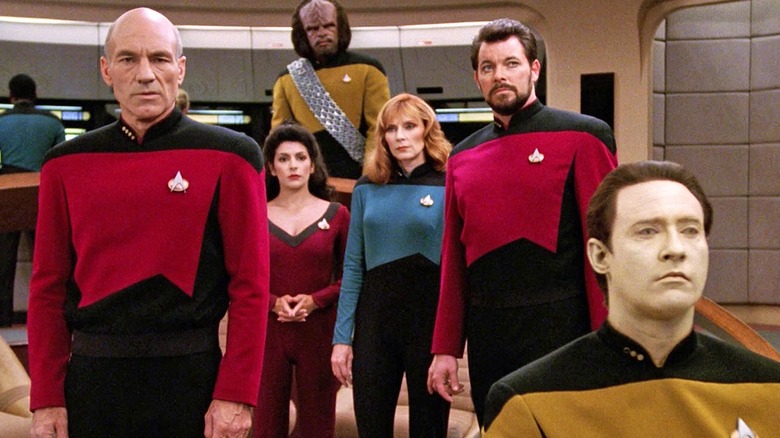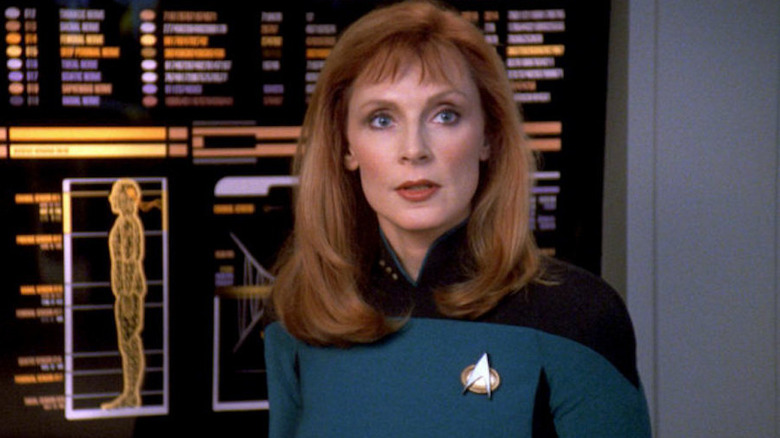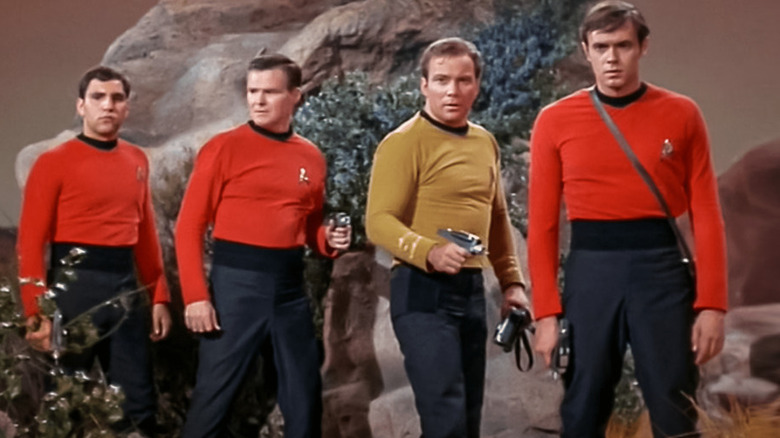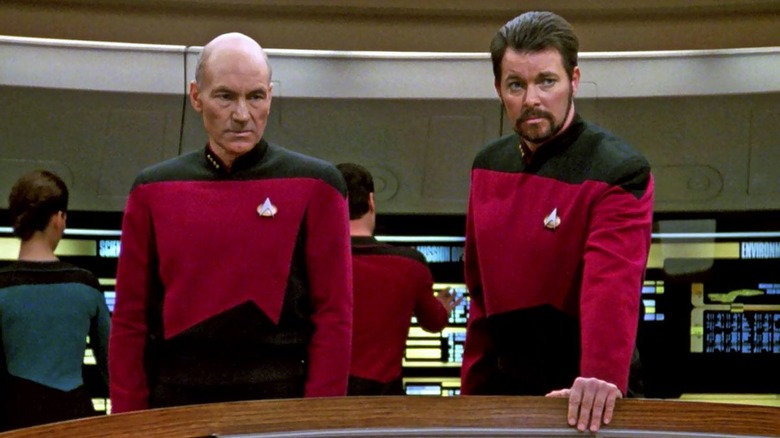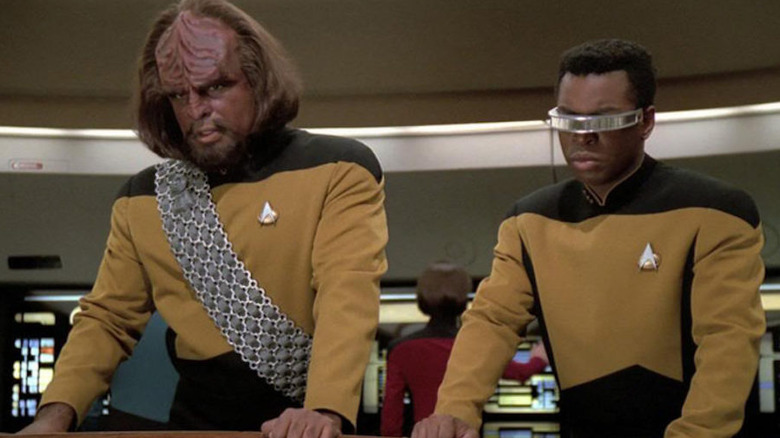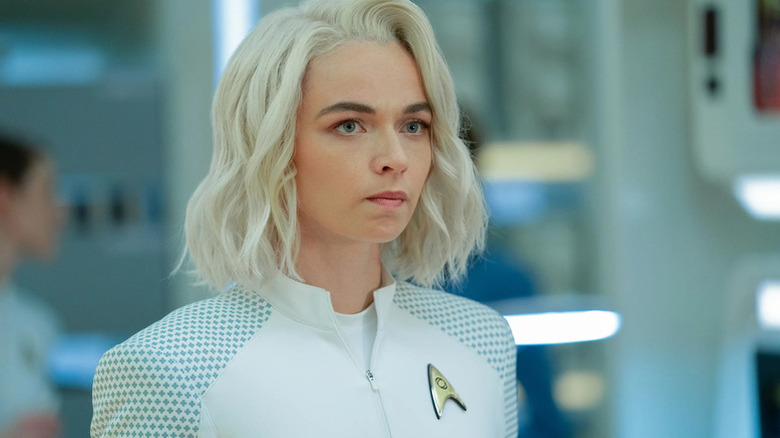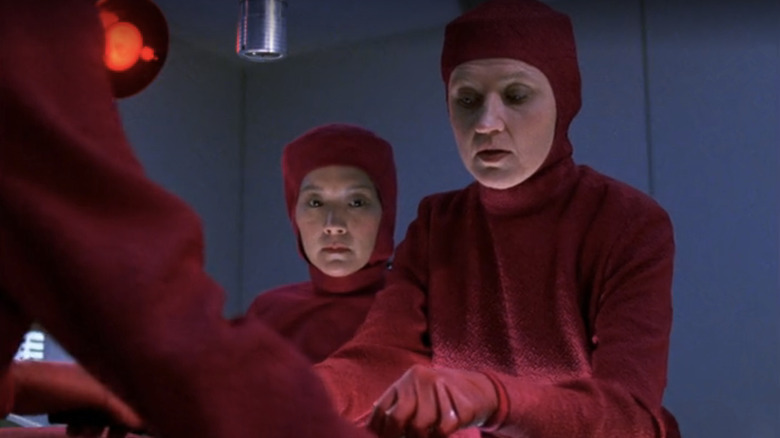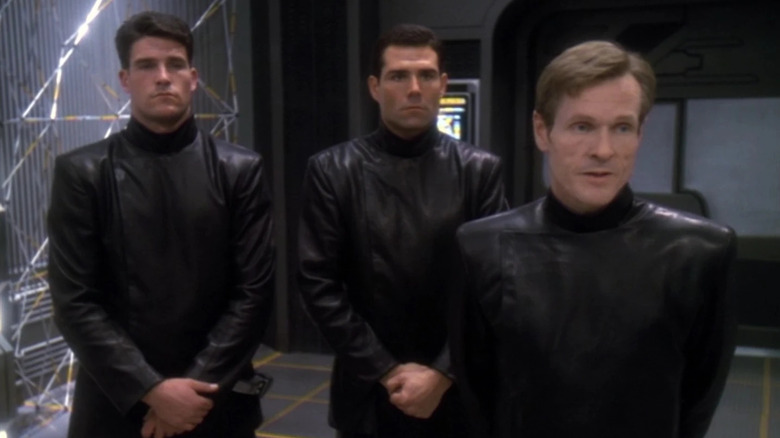Star Trek's Starfleet Uniform Colors Explained
"Star Trek" is arguably the greatest sci-fi franchise ever, and one of its hallmarks is its vibrant aesthetic. The show debuted in the 1960s with brightly colored uniforms that ran the spectrum of the rainbow. Legend has it that the colorful uniforms were at the behest of RCA, which owned NBC and wanted the show to demonstrate the power of new color televisions. Old ads that used "Star Trek" to promote the vibrancy of color sets suggest there's some truth to that legend. Inside the world of "Star Trek," though, what do these colors mean?
For those unfamiliar, each uniform color typically corresponds to a different division in Starfleet, the research and security arm of the United Federation of Planets. But figuring out which color means what isn't as simple as it might sound. That's because, over the years, color schemes have shifted, their meanings have changed, and prequels have retconned the past. So we're here to set the record straight with a handy guide to "Star Trek" uniform colors, from blue to red to gold and beyond.
Medical and science get the blues
There are few constants in this world, and while many will cite death and taxes, blue being the color for science and medical in "Star Trek" is another. Despite myriad changes over the years — with numerous color swaps and alternate uniforms created for various shows and movies — blue has always been the color to denote the sciences, going all the way back to Dr. Boyce in the first "Star Trek" pilot.
Since those days, blue has been the color for medical personnel like Dr. McCoy in "Star Trek," Dr. Crusher in "The Next Generation," and even the likes of Dr. Bashir in "Deep Space Nine," when Starfleet uniforms flipped the placement and put all the blue along the shoulders. Even in the far future of the 32nd century in "Star Trek: Discovery," blue remains the stalwart Starfleet color designation denoting science and medicine.
In the 1990s, though, the costume department was clearly testing out different shades, because sometimes science blue would become a bit more turquoise under certain light. And it's worth noting that "Star Trek: Discovery" experimented with doctors and science officers wearing all white, albeit briefly. But whether bright blue, dark blue, or even shades that have a bit of green in them, medical and science officers have always gotten the blues in the end.
Classic command goes for the gold
You might think of it as yellow, and in later years it was more of a mustard, but the classic gold is arguably the most iconic "Star Trek" uniform color. And that's owed largely to it being the color sported by Captain Kirk in the original "Star Trek" series, the show that started it all. In the early days of the franchise, of course, gold denoted command, so all Starfleet captains wore it.
In the first episodes of the original "Star Trek," even Spock wore gold before he became the show's science officer, while Ensigns Sulu and Chekov wore gold throughout the series, too. Though the '90s swapped some of the colors (more on that later), the legacy of the iconic gold tunic returned when J.J. Abrams brought the franchise back to its roots with the 2009 reboot films. There, Chris Pine, Anton Yelchin, and John Cho all wore updated versions of the gold Starfleet uniform, bringing the command gold back into the public consciousness.
With the release of the prequel series "Star Trek: Strange New Worlds," the gold tunic continues to be seen on screen, with Captain Pike, Commander Una Chin-Riley, and now a young James T. Kirk all adorned in classic command gold. But the ultimate irony is that, in the original "Star Trek," the gold uniforms weren't even gold — they were actually designed to be a shade of green that appeared gold due to bright studio lighting and fabric idiosyncrasies.
Red shirts must die
There are many elements from "Star Trek" that have made their way into the broader world of pop culture, elements that even people who don't watch science fiction are familiar with thanks to the franchise's dominance in the social sphere. Just about everyone knows the Enterprise, for example, but it goes beyond the franchise's iconic spacecraft — everyone knows the term "Red Shirts" means expendable foot soldiers who die first.
Officially, though, the original "Star Trek" series in the 1960s used red to denote operations and engineering divisions, which included the likes of Chief Engineer Montgomery "Scotty" Scott. But red was also the color for security teams, which is why the red-shirted crewman always seemed to be the first line of defense — and the first to drop dead at the sight of an enemy weapon.
Red proved so popular that when the movies came around, it became the color for all Starfleet crew members, no matter their division. Beginning with "Star Trek II: The Wrath of Khan," the iconic movie uniforms were a deep maroon, with a large front breast flap that could be pulled back during moments of relaxation. This change was brought about by director Nicholas Meyer, who reimagined Starfleet as a more naval-like military force, with a standard, single-color uniform throughout the fleet, heavily inspired by British Naval uniforms of the 19th century.
It ain't easy being green
As previously noted, the original iconic gold tunics used for the Command division on "Star Trek" weren't actually gold at all. According to costume designer William Ware Theiss, a satin velour was used that had a lime green hue, but when the show went before cameras — with overly lit studio lighting, combined with the limitations of 1960s film — they appeared on screen as gold or yellow. This explains why the Starfleet dress uniforms were much more lime in color, and why the alternate command uniform worn by Kirk in a handful of episodes was green — they were made using different fabrics that reacted differently to lighting on film than the satin velour.
Decades later, though, in "Star Trek: Strange New Worlds," producers brought back the bright green tunic, this time an official alternate uniform for Captain Pike. Often seen during formal occasions — a visiting dignitary in "Spock Amok" and a fancy crew dinner in "Wedding Bell Blues," for example — the green uniform variant is an updated, modern version of the classic Kirk wraparound tunic seen in the original series episode "The Trouble With Tribbles," among others. This time, however, the green is much bolder and darker, with the same Starfleet insignia pattern across the shoulders like all redesigned uniforms on the show. Though not specifically formal wear, it appears to be used at classier functions that don't require dress uniforms.
'90s Trek made red the leaders
"Star Trek: The Next Generation" debuted in 1987, nearly 20 years after the end of the original "Star Trek." It made a few big changes. The young, dashing Captain Kirk was out, and the older, balder Captain Picard was in. But, more importantly, gold was no longer the color of command, and red was no longer designated for expendable chumps. Now, red was the color of command, from admirals on down the line. The color swap is reportedly owed to Jonathan Frakes and Patrick Stewart, who producers felt didn't look right in classic command yellow. Putting them in red made more sense visually, but what about in-universe?
Well, over the years, fans have had plenty of theories, but there's never been an official canon reason for the swap. Red continued being the color for command through the '90s spin-offs and shows set in that era and beyond. Even when the entirety of Starfleet moved to grey-shouldered uniforms for the feature films and "Deep Space Nine," the division colors seen underneath retained red as command. And it held true for centuries: In the 23rd century era of "Star Trek: Discovery" Season 2, yellow is command just like in "The Original Series," but when the ship is transported nearly a thousand years into the future, the uniforms in "Discovery" Season 4 are still holding to red as the command color.
...and gold for security and engineering
With the debut of "Star Trek: The Next Generation," command now wore red, which meant moving the gold uniform color to another division, too, becoming security, operations, and engineering. Like the "red shirts" on the original "Star Trek," the new gold uniforms — or, more accurately, mustard, at this point — were worn by security personnel, though the "red shirt" stereotype still persisted in the zeitgeist. In the '90s, it was engineers like Geordi La Forge, Chief O'Brien, and B'Elana Torres wearing yellow, as well as security chiefs Worf and Tuvok (remember, security positions aboard "Deep Space Nine" were filled by Bajoran officers, not Starfleet).
Like command red, the gold uniforms during this era carried over into the 32nd century in the fourth and fifth seasons of "Star Trek: Discovery," with engineer Jett Reno sporting a gold uniform. Notably, however, there's been some confusion over the choice of a blue uniform for Commander Stamets, who mans engineering: He indeed wears blue, rather than gold, because he's technically an astromycologist, not an engineer. Still, the gold uniforms are probably most memorable from "The Next Generation," worn by many of the show's most popular characters. It's even become synonymous with the android Commander Data, who wore a similarly colored outfit as a non-Starfleet officer when he returned in Season 3 of "Star Trek: Picard."
Nurses wave the white flag
Blue uniforms might be the color for medical personnel in sickbay during the run of the original "Star Trek" in the 1960s, with Dr. McCoy, Dr. M'Benga, and Nurse Chapel all adorned in that hue, but more recent "Star Trek" shows have added another color of uniform to sickbay, with nurses — and at least one doctor — wearing white uniforms. Beginning in "Star Trek: Discovery," white uniforms could be seen on the ship's Chief Medical Officer Hugh Culber (Wilson Cruz), and there are at least two variants of this uniform.
The first version features a thick black stripe down one side, while the other is a white version of the standard "Discovery"-era uniform, with metallic accents along the side. Once the show moved to the 32nd century, Culber's uniform got an upgrade, but retained its colorless tone. When the spin-off series "Strange New Worlds" came about, there was a change, with the ship's doctor once again wearing blue. White uniforms have since been limited to nursing staff, with both Nurse Chapel and Ensign Gamble sporting white in sickbay alongside Dr. M'Benga.
Surgeons go red from head to toe
Blue and white aren't the only colors to be associated with doctors and medical staff in sickbay in "Star Trek." During the 1990s, shows like "The Next Generation" and "Deep Space Nine" added an all-red ensemble that went head to toe, including red gloves and a head covering. This red uniform style was specifically for use during surgery and was designed for sanitary reasons, hiding hair and skin as much as possible.
The red surgical scrubs first appeared in the "TNG" episode "Samaritan Snare," when Picard needed surgery on his artificial heart. They're worn again by Dr. Crusher, Nurse Ogawa, and visiting neurological specialist Dr. Toby Russell in "Ethics," seen during the touch-and-go spinal surgery performed on Lt. Worf. They showed up once more on "Deep Space Nine" in the episode "Life Support." In that installment, Dr. Bashir and his surgical staff are adorned in the red surgical scrubs while performing life-saving operations on Vedek Bareil.
Past "Deep Space Nine," we haven't seen the surgical scrubs again. Perhaps it's because they looked a little silly, or perhaps they simply fell out of favor. Maybe Starfleet developed a new means of sanitation for surgical procedures aboard starships.
Cadets get road greys
Over the years, cadets at Starfleet Academy have worn many different kinds of uniforms, but few of them were recognizable by a single color. For example, in the "Star Trek: The Next Generation" episode "The First Duty," which takes the Enterprise to Starfleet Academy in San Francisco, cadets wear a uniform with the division color on top along the shoulders and black below it. But when "Star Trek: Deep Space Nine" adopted that color arrangement as their standard uniform, cadets ditched it in favor of a grey uniform.
Seen most prominently in the "Deep Space Nine" episode "Valiant," Starfleet Cadet uniforms in this era were grey below the shoulders, with the division colors on top. Interestingly, the shade of blue used on cadets is far more in the turquoise range, but still seems to reference medical and science just the same. Since that era, grey seems to have been adopted across the franchise as the standard uniform color for cadets: The upcoming 2026 series "Starfleet Academy," set in the 32nd century, once more has cadets wearing a grey uniform with division colors as accents.
Acting ensigns are over the rainbow
From ensigns to lieutenants all the way up to admiral, uniforms for Starfleet officers all follow the same color scheme in their respective eras. In the '90s era shows, red was command, yellow was operations and security, and blue was science and medical. But there was still one additional rank that had its own unique uniform: Acting Ensign. The temporary rank was seen only in Season 1 of "Star Trek: The Next Generation," worn by Wesley Crusher after Captain Picard gave him the provisional rank of Acting Ensign.
The uniform worn by Crusher is all grey — a light grey below the shoulders, a dark grey above. But it also hides a simple, elegant detail in its multicolored stripe in between. Because, with Crusher not officially in Starfleet, he does not have an assigned division. His time as an acting ensign is intended to help him choose a division ahead of enrolling in Starfleet Academy, and thus his division is represented by all three colors. We haven't seen this uniform again, as after Season 2, the young Crusher gets an all-grey uniform before being promoted to full ensign.
Discovery tests its metals
When "Star Trek: Discovery" premiered in 2017, it featured a bold visual reinvention of the franchise. Despite being set about a decade before Kirk was captain of the Enterprise, the uniforms didn't resemble anything that we'd seen before. In a way, however, they linked the pre-Kirk era "Star Trek: Enterprise" with the future, with all-blue jump suits reminiscent of those worn by Captain Archer and the crew of the pre-Federation NX-01 Enterprise. Ditching the red/blue/gold color schemes, divisions were marked by metallic accents along the shoulders and sides.
While every crew member wears a deep, navy blue uniform, the metallic accents come in three different hues: Gold for command, silver for science and medical, and copper for operations. The problem was, though, that the metallic tones were hard to distinguish under certain lighting conditions, while the gold and copper were close enough that they were often hard to tell apart. What's interesting, however, is that when Captain Pike and the crew of the USS Enterprise became recurring characters in Season 2, they wore identical uniforms, but color-coded by division, with gold for command, red for security and operations, and blue for science and medical. Eventually, when Pike got his own series, the colors stayed, and the uniform design was streamlined.
Section 31 is back in black
"Deep Space Nine" was the first "Star Trek" series to take the grim and gritty route, offering some of the darkest stories the franchise has ever seen, even to this day. Controversially, the series explored the darker side of Starfleet with the introduction of Section 31, a rogue, clandestine intelligence agency that operates outside the chain of command and isn't above orchestrating coups around the galaxy. Agents of Section 31 have a history of being clad in all-black uniforms, with no Starfleet logos, division colors, or even rank insignia.
This uniform is first seen in the episode "Inquisition" when Deputy Director Sloan of Starfleet Internal Affairs is revealed to be an operative of the shadow organization called Section 31. When Sloan's true allegiance is confirmed at the end of the episode, he and his lackeys are seen in high-collared, black leather outfits more reminiscent of something out of George Orwell's "1984" than anything we'd expect to see from a Starfleet officer. And that's definitely by design, as Section 31 is said to operate more like a gang of ruthless, authoritarian thugs than the normally even-handed and peace-loving Federation security force.
J.J. Abrams' Section 31 are all black and blue
Many deemed the clandestine intelligence agency Section 31 too dark and dystopian an idea for "Star Trek," even in the late '90s, though they returned in a two-part episode of "Star Trek: Enterprise," revealing that they'd been around since before the founding of the Federation. Section 31 wasn't seen again until 2012, when, in a major twist, it's revealed that Section 31 is behind the release of the villainous Khan in J.J. Abrams' reboot film "Star Trek: Into Darkness" (which tops the list of "Star Trek" films by box office). And this time, they had a very different uniform color, ditching just black for black and blue.
Led by Admiral Marcus, Section 31 in the so-called Kelvin Timeline have their own massive starship, and their officers are decked out in a blue and black uniform. Like their counterparts in the Prime timeline, Section 31 operatives have no Federation or Starfleet logos or rank insignia. But the uniform appears to be worn across the entirety of Section 31, with Marcus and his entire crew, including its security team and Khan himself, all wearing the black and blue uniform. With no markings, the uniform makes them appear more like faceless drones than dedicated officers of Starfleet, which seems like it could be the point of its design.
